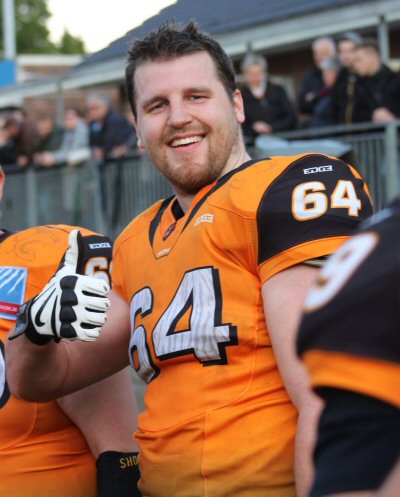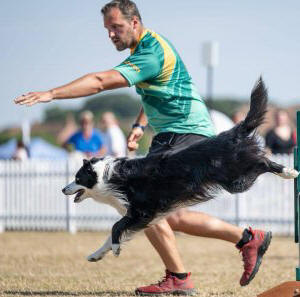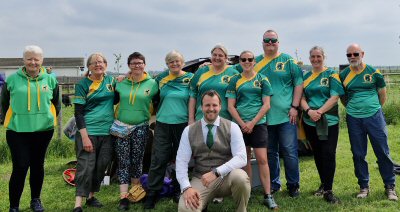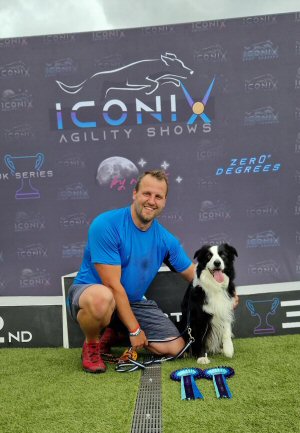| |
From the gridiron
to the agility ring...
 Between
2010 and 2016, Marcel Meinsen spent his weekends in cleats and pads, playing
offensive line for the Osnabrück Tigers in Germany. He started as a backup right
guard but quickly stepped into the starting role within his first season. By his
second year, he had transitioned to right tackle, where he held the starting
position until he traded his cleats for good for a life in the agility ring. The
experience was intense, physical and shaped by how much he understood about
teamwork, strategy and pressure. This is his extraordinary journey
from American football to dog agility. Between
2010 and 2016, Marcel Meinsen spent his weekends in cleats and pads, playing
offensive line for the Osnabrück Tigers in Germany. He started as a backup right
guard but quickly stepped into the starting role within his first season. By his
second year, he had transitioned to right tackle, where he held the starting
position until he traded his cleats for good for a life in the agility ring. The
experience was intense, physical and shaped by how much he understood about
teamwork, strategy and pressure. This is his extraordinary journey
from American football to dog agility.
Fast forward to 2022, and you'll now find me
in a completely different arena - the fast-paced, intricate world of dog
agility. What started several years ago as supporting my now fiancée as her
groom, queuing for her so that she could get herself and the dog ready to run,
cheering her on, filming runs and learning the ropes, quickly evolved into
something more. Inspired by the bond and teamwork between handler and dog, I
began training and running courses with my own dog. With my cheerful disposition
and hands-on mentality, I quickly established myself within the community and
found many new friends along the way.
In 2023, I took it a step further, becoming a
certified KC agility judge. By 2025, I had judged my first two qualifying
classes and had almost 30 appointments under my belt with more already in the
diary for 2026 and 2027. My dream is to become an established judge in my
homeland of Germany and to judge throughout Europe at some point, too.
 At
first glance, American football and dog agility might seem worlds apart, and in
many ways, they are. But I've found surprising overlap between the two, along
with some stark differences. At
first glance, American football and dog agility might seem worlds apart, and in
many ways, they are. But I've found surprising overlap between the two, along
with some stark differences.
-
Spatial awareness is crucial in both
sports
As an offensive lineman, you have to constantly be aware of your position,
the position of the other four linemen, your quarterback, the movements of
defenders and the flow of the play as well as predicting the flow of the
game. In agility, understanding the course layout, timing and how your
movements affect your dog's path are just as critical.
-
Reading the field or course correctly
Football taught me to
anticipate actions before they happen. That instinct has helped me as both a
handler and a judge - reading the dog-handler team's body language,
predicting potential handling options and analysing how course design
influences flow.
-
Mental discipline under pressure, coaching
and support
Both sports demand focus
when the stakes are high. Whether it's protecting the quarterback or keeping
your cool as your dog barrels toward a tight weave entry, you can't afford
to lose your head.
My role as a groom started with the same mindset I had in the locker room -
supporting teammates. Encouraging my fiancée through her runs reminded me of
the camaraderie and shared success I valued in football. It is a privilege
to do this sport together with her and to be able to support each other
through all stages of agility, be it at training, designing courses,
cheering each other on or looking after the dogs while I am out all day
judging. Without this team effort it would not be the same.
 The
differences between agility and American football The
differences between agility and American football
The main struggle for me was the pace and flow of
agility compared to the start-stop of American Football. I traded bursts of
intensity and reset afterwards for continuous, fluid and sustained rhythm while
running courses with my dog.
Football is about physical dominance and
split-second reactions. Dog agility, on the other hand, prioritises subtle but
precise body language, clear cues and harmony between handler and dog. You can't
(brute)-force a clear run!
This journey from the trenches of American
Football to the agility course has been unexpected but incredibly rewarding.
Trading a helmet for a leash, and a playbook for course maps, has opened a whole
new world of challenge, learning and joy.
Whether it's blocking blitzes or judging
contacts, I've found that it's discipline, focus and a love for the game -
whatever form it takes - that represent the cornerstones for success.
 About
the author About
the author
Marcel Meinsen was
born and raised in Northrhine Westfalia in Germany. His family didn't have any
pets when he was growing up as his father was allergic, but his fiancée's family
always had dogs and, as they have known each other for most of their lives, he
feels he sort of 'grew up' with dogs.
She grew up in Germany just 20 minutes away
by car from the town where Marcel was living. They met when both were 16 while
chatting online. Eventually they agreed to meet up in December in 2006 and have
been together ever since. Though she was already living back in the UK at the
same time, they were able to maintain their long-distance relationship
throughout their university years and the start of their careers.
While he was studying, Marcel tried out for
American football and joined the Osnaburgh Tigers, an independent club in the
regional third division. It was a small sport in Germany, and he had to buy his
own equipment and a new jersey every year. He played for them for six years.
After visiting the UK for over 14 years,
Marcel was able to move here part-time in 2021 on a tourist visa for six months
at a time. This suited his agility schedule well as he was able to compete at
shows from April to September without having to leave too frequently for
Germany.
Marcel currently competes with his Border
Collie, Gus. He is a KC accredited judge and agiity instructor as well as a
member and Chairman of Empingham DTC.
In 2024 he was able to get a visa approved
and to look for a job in the UK. At present, he works in sales for a cyber
security company.
Photo credits
First
published: 30th September 2025
First published 5th October 2025
| |
|